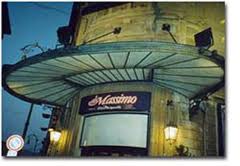
Read Italiano version
e-mail: botteghino@teatroalmassimo.it
Maggiori info: http://www.teatroalmassimo.it
The building of Al Massimo – originally created as a Cinema – Theater Massimo – is an admirable reinforced concrete structure designed by Giovan Battista Santangelo (1889-1966), an engineer who trained at the school of Ernesto Basile. The Cinema Massimo was inaugurated in 1924. Next to the big screen is the name of its first clients: the Biondo Family – the same Biondo Family that signed other theatrical and entertainment seasons in Palermo. The cinema Massimo, before, during and after the war, was directed by the master Gaetano Romeres, a well-known and beloved musician in Palermo. In those dramatic years with its relative interruptions, the playhouse defined the function of “cine-theatre”, that is, cinema and variety. The variety show, the best entertainment, was offered every day in the afternoon and in the evening. The audience looked forward to the movie ending in order to enjoy the show. The final walk along the front stage literally sent the audience – the male one of course – into raptures. The variety and avanspettacolo (comic show developed in the thirties) companies that performed at the “Massimo” came from all the most disparate locations in Italy. At the end of the conflict life slowly returned to a normal daily routine, so the “Massimo” resumed its activity and until the early 1960s it retained its cine-theater characteristics. Then the crisis of the avanspettacolo companies worsened, the theater program became somewhat restricted, until the fateful month of June 1977 which saw its closure. On November 20, 1992, thanks to the commitment of a group of show operators the theater was completely renovated, restored and adapted to modern techniques, and finally the “Al Massimo Theater” was inaugurated with a show by Gigi Proietti. This playhouse is currently the most important private enterprise of its kind in Sicily; with its series of theater performances of Comedies and Shows it hosts the largest national and international companies, boasting an audience of about 200,000 spectators per theatrical season.
